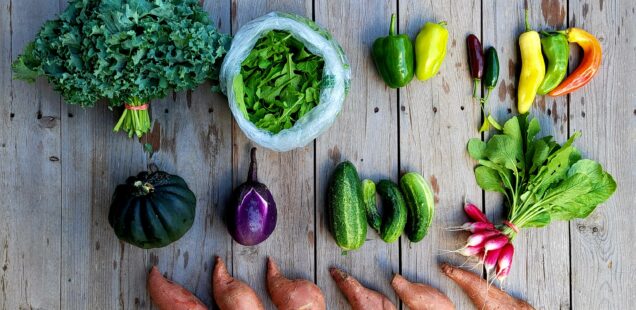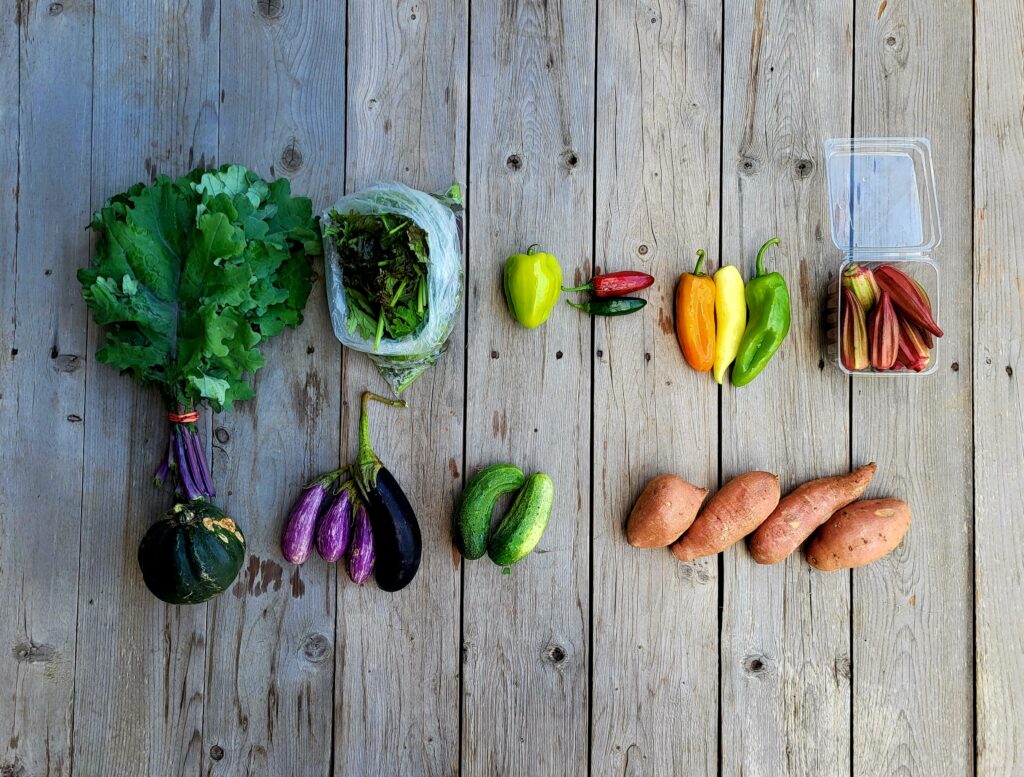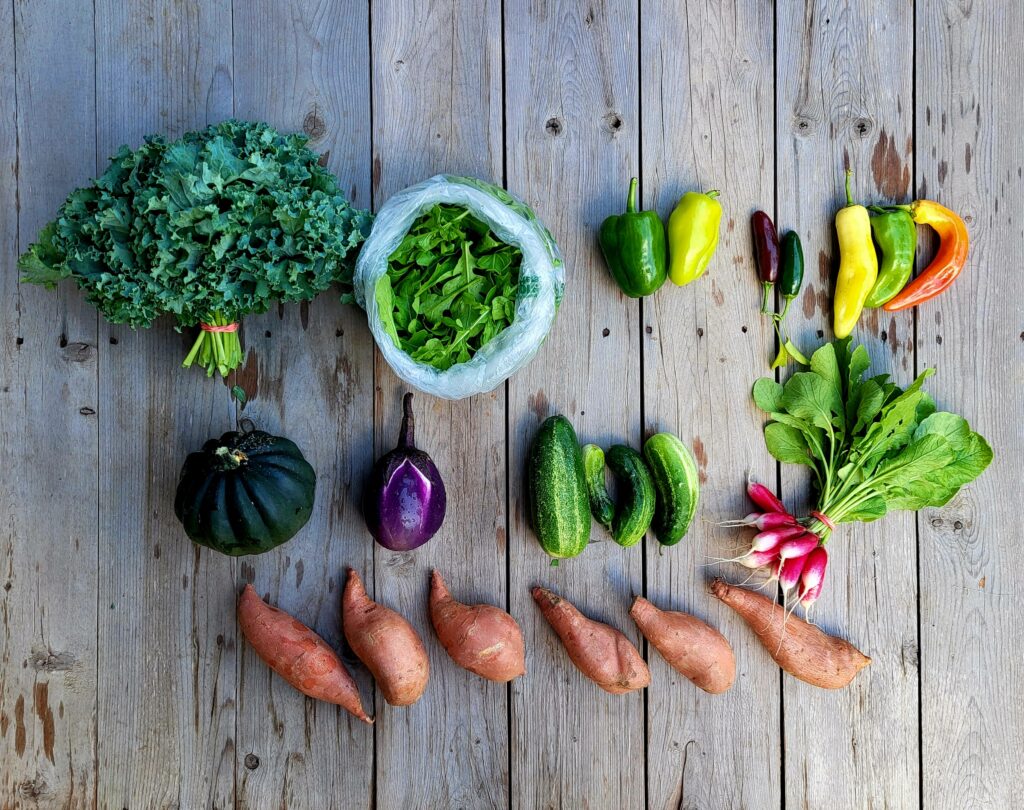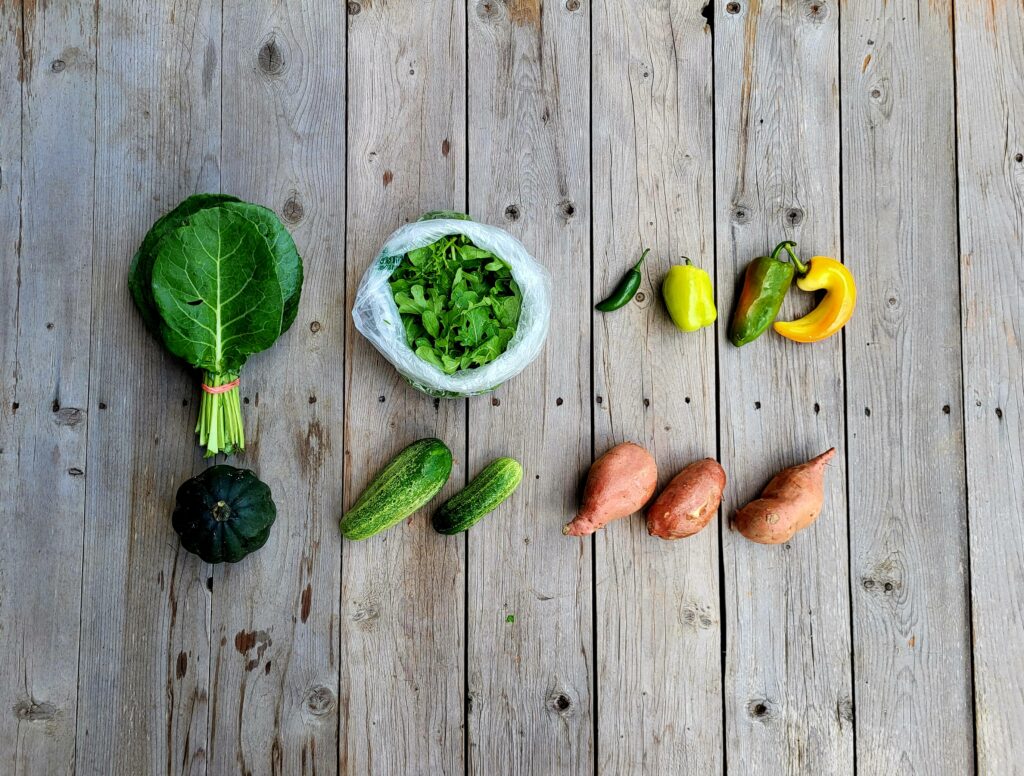
Share Notes Oct. 9, 2025
CSA Share Notes:
We’re so excited to kick off the Fall CSA season this week! The garden goes through pretty rapid change over the course of the first month of the fall season. The first few weeks will mostly be heat-loving summer crops (cucumbers, peppers, eggplant, okra,) while the cool season crops of leafy greens and crunchy roots gradually rotate in as they become ready. The summer crops are fleeting and will be gone as soon as the first frost hits (which we don’t think will be till November, we hope), so enjoy them while we’ve got them!
Now here’s your vegetable line-up:
- Collard or Kale — Large shares received our Winterbor kale, curly, and delicious. Regular shares received our Red Russian Kale, a delicious, tender kale, perfect for raw salads, excellent as a slaw, fantastic sauteed. Mini shares received Collard Greens. We always suggest you cook collards up southern style with a little bacon or ham, onion, garlic, and crushed red pepper flakes. Finishing with a dash of vinegar is in line with tradition.
- Eggplant — Large and Regular shares received eggplant. Large shares mostly receievd out Italian types, and Regular shares mostly received our Japanese types. My best eggplant tip is cook it HOT and FAST. You want a good browning as this really brings out the sweetness. Grill, oven roast at 450, or blister in a super hot cast iron. Some years we have a huge abundance of this crop, but not this year. We’ll only have a little to offer until it peters out.
- Bell Peppers — Everyone is receiving a couple of beautiful bell peppers. This crops is beginning to slow down for the year, but we’re still getting a few each week.
- Italian Peppers — These long, slender peppers are so delicious, with no hint of spice. They’re great for fresh-eating, using with dips, making rings for homemade pizza, or cutting into long strips for a batch of fajitas. Enjoy many more for the next few weeks until we get a frost!
- Hot Peppers — A taste- just 1-2 Jalapenos for each share, but it’s enough to flavor a meal this week.
- Okra — This is our lovely heirloom Hill Country Red okra, super delicious. We love to roast it in a hot oven or grill it to avoid heating up the kitchen. It’s also wonderful raw! We had just enough to give it to the Regular shares.
- Acorn Squash — These did GREAT this year! (although I can’t say the same for the butternut. Wild hogs got into those about 2 weeks ago, and boy did they enjoy themselves!). We’re so glad we got the planting timing just right on these acorn squash, and we’ll be able to provide you with delicious acorn squashes several times this season from our stash of this hearty storage crop.
- Arugula — For Large and Mini sharesTender and peppery, this is my favorite salad green. It’s excellent with pecan, and fresh or dried fruit, a bit of red onion, and a sweet dressing, like a maple dijon. A bit of blue cheese, feta, or chevre, and now you’ve got yourself one of them fancy restaurant salads.
- Asian Mustard Mix — For regular shares. This frilly, spicy salad green is super flavorful! It’s great raw but can also be sauteed if you prefer your greens cooked. Perfect to pair with your kale.
- Radish — French Breakfast radish for the Large shares. These slender radishes with pink tips are my favorite. They’re just so pretty.
Items from other neighboring farms:
- Tony Philips Sweet Potatoes — Our friend and neighbor Tony Philips grows the regions best sweet potatoes, just a couple of miles from Red Moon Farm. These are fantastic, sweet, with a long storage life. Enjoy them on the regular. You’ll get lots more throughout the fall!
- A few notes about Tony’s Practices: He is not aiming to be organic, so some years the above-ground parts of the plants have non-organic products used on them, however, the roots never have anything applied to them.
- Usual standard practice in commercial sweet potato production is to use sprout-inhibitors on the crop post-harvest, and these chemical compounds are known to be extremely harmful to the thyroid and other hormonal systems in the human body.** (It’s why, when we can’t get them from a local grower and have to rely on a grocery store, our family chooses to only buy organic potatoes, sweet potatoes, onions, and garlic.) Well, Lucky us: Tony Philips never, ever uses sprout-inhibitors. His potatoes simply get a clean water bath to rinse the ETX sand off of them, so we eat them with confidence, and we believe you can, too.
- Tanksley Farm’s Cucumbers — We met Lowell Tanskley through the Historic Longview Farmers Market 4 years ago, and he’s proven year on year to provide extremely high quality crops to the community. While his practices are not organic, he hasn’t needed to spray anything on this planting of cucumbers, so they’re pretty darn clean. That’s the nice thing about growing cukes in the fall, the pest and disease problems are much fewer during this dry time of year. The nice guy injured his knee this weekend and needed a bit of help with his harvest, so these were a generous gift in exchange for a bit of help we could offer. So glad to pass them on to you lovely people.
Veggie Storage tips:
- Everything wants to be washed well before cooking, but keep the dirt on till then, to prevent faster spoilage.
- Basil must not be stored in the fridge. Keep it in a glass of water in a cool place, and out of direct light.
- Peppers, okra, cucumbers, and eggplant all want to be in your fridge. Seal them up in a bag or container to retain moisture for longest storage life.
We’d love to hear stories and recipes of your culinary adventures this week. Tag us on Instagram or Facebook, showing us how you’ve used your CSA share.
Your farmers, Jess & Justin
Regular Share
Regular Share top left to right: Red Russian kale, Asian Spring mix, Bell pepper, jalapenos, Italian peppers, Okra, (2nd row) Acorn squash, eggplant, cucumbers, and sweet potatoes.
Large Share
Large Share top left to right: Winterbor kale, arugula, Bell peppers, jalapenos, Italian peppers (2nd row) Acorn squash, eggplant, cucumbers, French Breakfast radish, and sweet potatoes.
Mini Share


